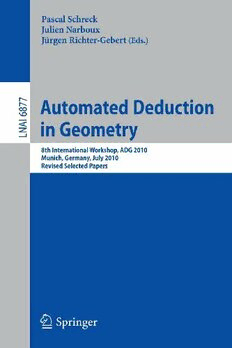Table Of ContentLecture Notes in Artificial Intelligence 6877
Subseries of Lecture Notes in Computer Science
LNAISeriesEditors
RandyGoebel
UniversityofAlberta,Edmonton,Canada
YuzuruTanaka
HokkaidoUniversity,Sapporo,Japan
WolfgangWahlster
DFKIandSaarlandUniversity,Saarbrücken,Germany
LNAIFoundingSeriesEditor
JoergSiekmann
DFKIandSaarlandUniversity,Saarbrücken,Germany
Pascal Schreck Julien Narboux
Jürgen Richter-Gebert (Eds.)
Automated Deduction
in Geometry
8th International Workshop, ADG 2010
Munich, Germany, July 22-24, 2010
Revised Selected Papers
1 3
SeriesEditors
RandyGoebel,UniversityofAlberta,Edmonton,Canada
JörgSiekmann,UniversityofSaarland,Saarbrücken,Germany
WolfgangWahlster,DFKIandUniversityofSaarland,Saarbrücken,Germany
VolumeEditors
PascalSchreck
LSIIT,PôleAPI
BoulevardSébastienBrant,BP10413
67412IllkirchCédex,France
E-mail:schreck@unistra.fr
JulienNarboux
LSIIT,PôleAPI
BoulevardSébastienBrant,BP10413
67412IllkirchCédex,France
E-mail:narboux@unistra.fr
JürgenRichter-Gebert
TechnischeUniversitätMünchen,ZentrumMathematik(M10)
LehrstuhlfürGeometrieundVisualisierung
Boltzmannstraße3
85748Garching,Germany
E-mail:richter@ma.tum.de
ISSN0302-9743 e-ISSN1611-3349
ISBN978-3-642-25069-9 e-ISBN978-3-642-25070-5
DOI10.1007/978-3-642-25070-5
SpringerHeidelbergDordrechtLondonNewYork
LibraryofCongressControlNumber:2011940216
CRSubjectClassification(1998):I.2.3,I.3.5,F.4.1,F.3,G.2-3,D.2.4
LNCSSublibrary:SL7–ArtificialIntelligence
©Springer-VerlagBerlinHeidelberg2011
Thisworkissubjecttocopyright.Allrightsarereserved,whetherthewholeorpartofthematerialis
concerned,specificallytherightsoftranslation,reprinting,re-useofillustrations,recitation,broadcasting,
reproductiononmicrofilmsorinanyotherway,andstorageindatabanks.Duplicationofthispublication
orpartsthereofispermittedonlyundertheprovisionsoftheGermanCopyrightLawofSeptember9,1965,
initscurrentversion,andpermissionforusemustalwaysbeobtainedfromSpringer.Violationsareliable
toprosecutionundertheGermanCopyrightLaw.
Theuseofgeneraldescriptivenames,registerednames,trademarks,etc.inthispublicationdoesnotimply,
evenintheabsenceofaspecificstatement,thatsuchnamesareexemptfromtherelevantprotectivelaws
andregulationsandthereforefreeforgeneraluse.
Typesetting:Camera-readybyauthor,dataconversionbyScientificPublishingServices,Chennai,India
Printedonacid-freepaper
SpringerispartofSpringerScience+BusinessMedia(www.springer.com)
Preface
From July 22 to July 24, 2010, the Technische Universit¨at Mu¨nchen, Germany,
hosted the eighth edition of the now well-established ADG workshop dedicated
to Automatic Deduction in Geometry. From the first edition, which was held
in Toulouse in 1996,to ADG 2010, a slow mutation has taken place. The work-
shopthatwasformerlycenteredaroundcomputeralgebrabecamealargerforum
where several communities could exchange new ideas coming from various do-
mains, such as computer algebra, logic, computer-assisted proof, combinatorial
geometry or even software development, but all focused on proof in geometry.
ADG2010wasafruitfulmeetingwhere19papers,from22submissions,were
selected for presentation after a review process involving at least two reviewers
per article. The set of presentations was completed by an invited talk given
by Robert Joan-Arinyo from the Universitat Polit`ecnica de Catalunya, Spain.
ADG 2010 was also an enjoyable meeting thanks to the rigorous and flawless
organizationof the Munich team (see the Organizing Committee list).
Afterthemeeting,anewcallforpaperswaslaunched,acceptingcontributions
not necessarily related to a presentation at ADG 2010.
The present volume of the LNAI series is the result of this selection process,
which includes a new review process and discussions within the ProgramCom-
mittee. It is composed of 13 papers which present original research reflecting
the current state of the art in this field. The following categorization proposes
a key to understanding the papers.But, obviouslyas with allcategorizations,it
is rather arbitrary and it should not be taken strictly. Most papers can indeed
also be considered from a radically different point of view.
Three papers deal with incidence geometry using some kind of combinatoric
argument.Susanne Apel and Ju¨rgen Richter-Gerbertexplore two ways to auto-
matically prove a geometric theorem by discovering cancellation patterns. Do-
minique Michelucci studies incidence geometry leading to two papers: one deals
withanabstractnotionofline andthe otherconcernshumanreadableproofsin
geometry.
Threepapersfallinthedomainofcomputeralgebra.DanielLichtblaustudies
a problem related to the locus of the midpoint of a triangle in a corner, which
is a variant of the “penny in a corner” problem, by using numeric, formal and
graphical tools. Pavel Pech exposes a method to automatically prove theorems
relatedto inequalities in geometry.Yu ZouandJingzhongZhangproposea way
to generate readable proofs using the so-called Mass Point Method involving
barycentric calculations with real or complex masses.
Fourpapersaremorerelatedtosoftwareimplementation.MichaelGerhau¨ser
and Alfred Wassermann present a Web-integrated software for dynamic geom-
etry which includes a Gro¨bner-based tool able to compute plane loci. Fadoua
Ghourabi, Tetsuo Ida and Asem Kasem expose methods to produce readable
VI Preface
proofs of theorem within the Origami problematics. Pedro Quaresma describes
TGTP—alibrary ofproblems forautomatedtheoremprovingin geometry.Phil
Scott and Jacques Fleuriot present the concurrent implementation of a forward
chaining algorithm in the Isabelle/HOL framework.
Last but not least, logic and proof assistants are the subject of three papers
ofthisbook.Followinghis ownworkonnon-standardanalysis,JacquesFleuriot
explores the foundations of discrete geometry in Isabelle/HOL. Laurent Fuchs
andLaurentTh´eryrepresenthereboththe Coqandthe geometricalgebracom-
munities by presenting the formalization in Coq of Grassmann Caley Algebra
and its application to automatize the production of proofs in projective geom-
etry. Sana Stojanovi´c, Vesna Pavlovi´c and Predrag Janiˇci´c expose a framework
where coherent logic is used to implement a geometric prover able to deliver
readable proofs.
Our gratitude goes to the Chairsof the previous editions of ADG. We thank
them for their guidance and for having made ADG what it is now. We would
also to thank the ProgramCommittee and the numerous referees who did a lot
of work to improve the quality of the workshopand of this book.
July 2011 Pascal Schreck
Organization
Organizing Committee
Ju¨rgen Richter-Gebert (Germany), Chair
Jutta Niebauer (Germany)
Program Committee
PascalSchreck (France), Chair Julien Narboux (France)
Hirokazu Anai (Japan) Pavel Pech (Czech Republic)
Francisco Botana (Spain) Tom´as Recio (Spain)
Jacques Fleuriot (UK) Georg Regensburger (Austria)
Xiao-Shan Gao (China) Ju¨rgen Richter-Gebert (Germany)
Predrag Janiˇci´c (Serbia) Meera Sitharam (USA)
Deepak Kapur (USA) Thomas Sturm (Spain)
Ulrich Kortenkamp (Germany) Dongming Wang (France)
Montserrat Manubens (Spain) Bican Xia (China)
Dominique Michelucci (France)
Bernard Mourrain (France)
Invited Speaker
Robert Joan-Arinyo (Spain)
External Reviewers
Xiaoyu Chen Sana Stojanovi´c
Oliver Labs John Sullivan
Filip Maric Hitoshi Yanami
Vesna Pavlovi´c Lu Yang
Phil Scott Christoph Zengler
Table of Contents
Cancellation Patterns in Automatic Geometric Theorem Proving....... 1
Susanne Apel and Ju¨rgen Richter-Gebert
Exploring the Foundations of Discrete Analytical Geometry in
Isabelle/HOL.................................................... 34
Jacques Fleuriot
A Formalization of Grassmann-Cayley Algebra in Coq and Its
Application to Theorem Proving in Projective Geometry.............. 51
Laurent Fuchs and Laurent Th´ery
Automatic Calculation of Plane Loci Using Gr¨obner Bases and
Integration into a Dynamic Geometry System ....................... 68
Michael Gerha¨user and Alfred Wassermann
Proof Documents for Automated Origami Theorem Proving ........... 78
Fadoua Ghourabi, Tetsuo Ida, and Asem Kasem
The Midpoint Locus of a Triangle in a Corner ....................... 98
Daniel Lichtblau
Some Lemmas to Hopefully Enable Search Methods to Find Short
and Human Readable Proofs for Incidence Theorems of Projective
Geometry....................................................... 118
Dominique Michelucci
What Is a Line ?................................................. 132
Dominique Michelucci
On One Method of Proving Inequalities in Automated Way ........... 152
Pavel Pech
Thousands of Geometric Problems for Geometric Theorem Provers
(TGTP) ........................................................ 169
Pedro Quaresma
An Investigation of Hilbert’s Implicit Reasoning through Proof
Discovery in Idle-Time............................................ 182
Phil Scott and Jacques Fleuriot

